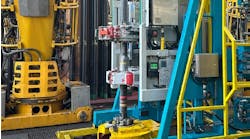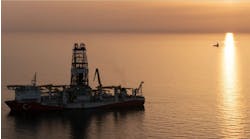Eldon Ball • Houston
Seismic survey activities in the Asia-Pacific are setting new records in response to growing energy demand in local economies. Geophysical companies are expected to set up pre-concession bidding-data libraries, introduce more 4D shoots, and perform intensive deepwater subsurface surveys using the wide-azimuth towed-streamer acquisition technology that is widely used in the Gulf of Mexico.
The Asian market has made progress as most of the region’s major hydrocarbon provinces are seeing renewed efforts in subsurface data collection to meet growing demand in the region and to fully exploit indigenous energy resources.Offshore’s Contributing Editor for Asia-Pacific Gurdip Singh reports, beginning on page 40.
Major Asia-Pacific technology exchange
Meanwhile, the growing offshore and deepwater exploration and production activity in the Asia-Pacific region has created a need for technology exchange. PennWell’sOffshore Asia 2008 Conference & Exhibition in Kuala Lumpur, Malaysia, is filling that need. The 2008 event, from March 17-19 at the Kuala Lumpur Convention Centre, will examine the newest developments in this rapidly expanding offshore area. Over 4,000 offshore oil and gas professionals and more than 70 exhibitors from around the world are expected at the conference.
The conference theme, “New Growth, Technology and Market Changes,” focuses on the challenges of the Asian offshore arena – growth, opportunity, and changing operating conditions.Tracy Dulle, Technology Editor, Surface Systems & Vessels reports on the full conference proceedings, beginning on page 44.
Offshore rig market unfazed by new entries
With the US Gulf of Mexico rig market experiencing a downward trend in its fleet size as slack demand drives rigs from the area, other regions of the world are not only compensating with strong rig demand, but also benefiting from the US Gulf market’s troubles. AsJustin Smith of ODS-Petrodata points out, while demand for jackups in the US Gulf has declined as operators’ preferences steer toward the region’s deeper waters, the idled jackups are finding work in places like the Middle East and West Africa.
With other regions picking up the slack from the US Gulf, worldwide offshore rig utilization has remained almost completely flat for all of 2007, even while new rigs enter the global fleet. Fleet utilization around the world started 2007 at 89.1% as 612 of the 687 available rigs were contracted. Currently, 629 of the world’s 703 jackups, semis, drillships, barges, tenders, submersibles, and arctic rigs are contracted, and fleet utilization is at 89.5%. See the full report, beginning onpage 30.
Subsea equipment qualification
Consistent, practical ways to define equipment qualification and testing can improve subsea reliability and can facilitate project execution. ExxonMobil Development Co. (EMDC) has developed a systematic, structured approach to equipment qualification using failure mode assessment (FMA) templates and product qualification sheets (PQS).
These are based on existing industry methods that support equipment design reviews and provide uniform display of information.
To develop this subsea qualification process, several principles and tools were identified and developed based on lessons learned from recent deepwater projects, vendor input, and a review of previous standardization initiatives.
By adopting this qualification format, the deepwater industry can more efficiently manage operator and vendor interfaces by highlighting critical design features, and also take advantage of existing component qualification programs.
This process also facilitates execution efficiencies, reduced delivery schedules, and capture of lessons learned. AuthorsC. S. Horan, M. G. Starkey, D. C. Lucas, and S. A. Wheeler of ExxonMobil Development Co. describe the system in detail, beginning onpage 96.
To respond to articles in Offshore, or to offer articles for publication, contact the editor by email ([email protected]) or fax (1-713-963-6296).


